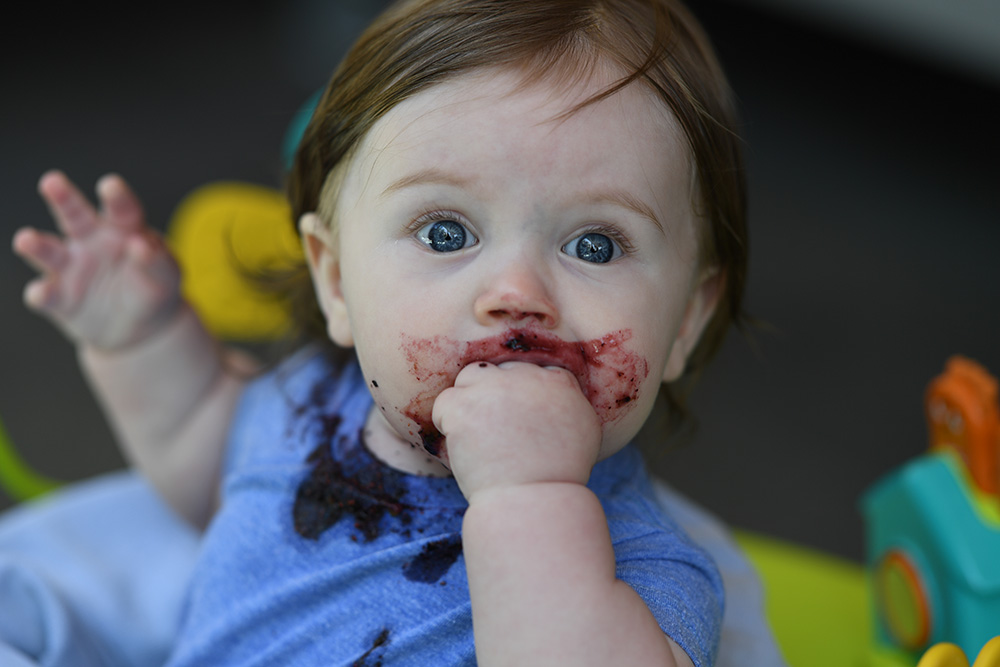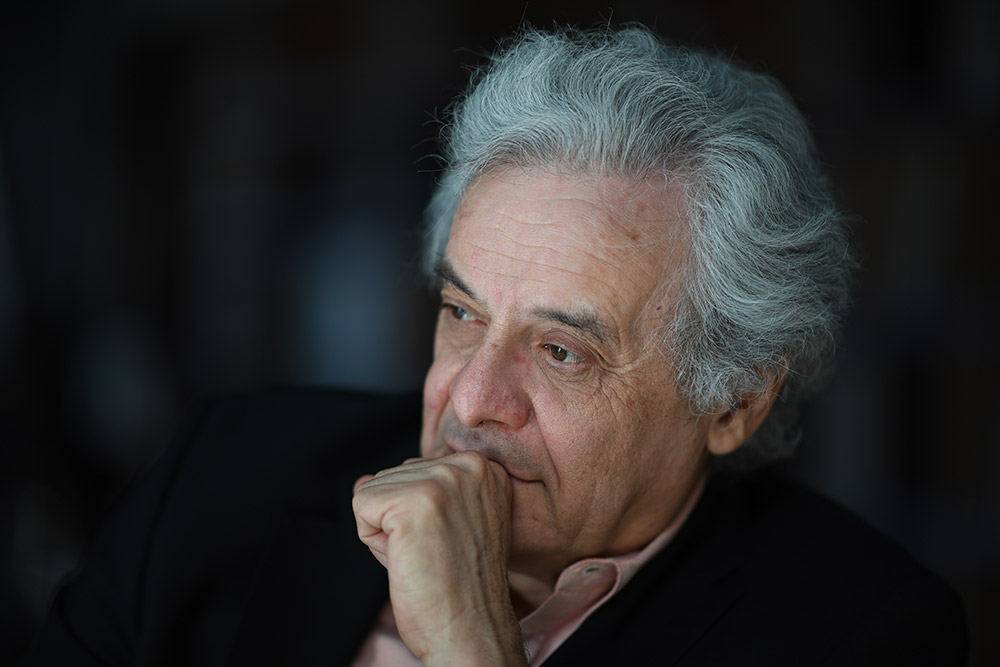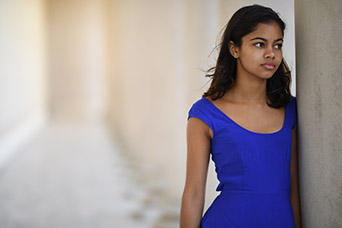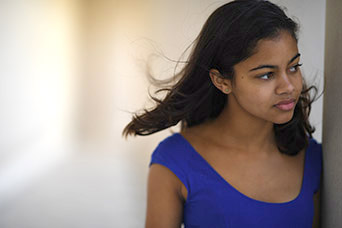The Lens is the Brush. The Sensor is the Canvas.
Portrait photography with Vincent Versace & the NIKKOR 105mm f/1.4 lens
No strobes. No added artificial light. No reflectors. No diffusers. Just a camera and a lens shot “wide open” in cinematic style for Nikon Ambassador Vincent Versace, who tested the new AF-S NIKKOR 105mm f/1.4E ED in several portrait settings.
A self-proclaimed zoom lens guy, Versace totes a stash of NIKKOR lenses that span various telephoto ranges. “I have space for only 10 lenses in my bag. Why so many? I consider each lens to be an essential brush that does a very particular job, so it takes a lot to get me to replace one for another—particularly if it’s a prime.” Turns out the AF-S NIKKOR 105mm is pretty prime. In fact, so prime that it has ousted a brush that’s been inside his case since 1989. “The 105mm is remarkable. I made the switch after working with it for just a week.”
A Prime Cause
Fond of the phrase, “I don’t take a photograph, the photograph takes me,” Versace himself is smitten with this new NIKKOR, engineered for precise handling of bokeh; bokeh being how the lens renders fall-off between what is in focus and what drifts into non-focus. “At f/1.4, this lens is blindingly sharp at its point of focus. For portrait photographers it dazzles the sweet spot—generally the f/1.4 to f/5.6 range. Admittedly there’s a learning curve to understanding how to work within its shallowness for depth of field and critical point of focus range, but when you nail the shot it is truly breathtaking! This piece of glass renders the prettiest bokeh you will see.”
There are a few reasons why the 105mm is his new favorite. First is distance. “I was taught that between 85mm to 105mm is approximately what the naked eye sees when looking straight ahead. Peering through a 105mm lens shows little to no distortion or alteration, and is akin to what our eyes perceive. Since the lens permits me to work from a distance, I can produce intimate images without invading a subject’s personal space, making it ideal for street photography, plus both studio and environmental portraiture.” Third, Versace is bowled over by its sharpness. Fourth, he says it’s all about the bokeh.
“For me, the prettiest aspect of an image is not so much in the areas of focus, but in where the lens ramps from in-focus to blur,” remarks Versace. “The ineffable quality of a lens is bokeh. Neutral bokeh is something that’s frequently achieved, but to go the step beyond to a beautiful bokeh—that is rare and precious. In my opinion, prior to the 105mm there was no real way to measure it or to design for it; it was present or it was not.”
Shot on the Nikon D5 with AF-S NIKKOR 105mm f/1.4E ED. ISO 100 lens, 1/250th, f/2.8.
Keeping an Eye on Baby Jonas
Among his first photography test subjects, Versace opted for baby Jonas. “I got schooled by a child,” Versace quips. “The lens has such precision and shallowness in depth of field at f/1.4 and its minimum focusing distance, that the infant’s slightest movement shifted what was in focus and was not in focus. Babies move at the speed of life, which is faster than this photographer can shoot, so I switched from single servo to Group Area-area AF mode. That kept a desired region in focus while I concentrated on learning more about minimum focusing distance (1.0 m. / 3.3 ft. from focal plane).”
For this assignment, working wide open and strictly at the minimum focus distance, Versace’s images present mere inches of sharpness with subtle fall-off. “What results is a tack sharp region to the eyes, with the softest of focus fall-off. Jonas is finely isolated from his backdrop.” The art of the portrait comes while waiting for the right moment. “I was captured by my subject,” smiles Versace. “The best image doesn’t happen merely through interaction with camera or subject or photographer. It happens in the space created between the photographer and the subject.”
Shot on the Nikon D5 with AF-S NIKKOR 105mm f/1.4E ED lens. ISO 100, 1/40th, f/1.4.
In another image, observe Frank the mechanic as he converses with an associate who is out of frame. The only illumination comes from a garage shop door open one-third up from the ground, light reflecting into the subject’s face. Versace stands 3.3 feet away and is shooting handheld, nearest eye selected as focus point. With the Nikon D5 set to Auto ISO and lens remaining at f/1.4, he freezes the dialogue. “A photographer has the power to choose what is in focus and what is not in focus—just as a painter determines how pigment is placed by his choice of brush. I liken my lens to a brush, and a sensor to the canvas. Each brush has a specific quality and works to a specific purpose.”
Landscape of the Face
Talking theory, Versace comments about two camps of photography: those who feel all should be in focus (for example landscape photographers who often set aperture to infinity), and those who stridently select a region of focus (cinematographers and photographers who manipulate aperture settings to throw attention on an exact region). For the latter, power to direct the viewer’s eye starts with basic decisions. “Focus, as governed by aperture, is a powerful tool. Generally speaking, the eye gravitates first to what it recognizes. It then goes from light to dark, high contrast to low contrast, then sharpest region in an image to blur. I keep all of these things in mind when creating a portrait.”
More often than not, Versace places point of focus on an eye or the eyes. He then determines how and what else to present. “By manipulating depth of field I control what the viewer takes in. I control area of attack, the point of focus and I control retreat, or blur. The 105mm brings utter brilliance at point of focus, combined with the most amazing and gentle shift into bokeh.”
Shot on the Nikon D5 with AF-S NIKKOR 105mm f/1.4E ED lens. ISO 100, 1/25th, f/1.4.
Continuing, he adds, “A portrait tells the landscape of that person’s life.” Photographed from within a 30,000 square foot San Francisco warehouse, Luis sits just paces from a cluttered background of crates, containers, shelves and forklifts, yet all objects are rendered imperceptible. The sole contribution of light drifts in from a window 30 feet overhead and 50 feet away, punctuating each pupil. “My objective is to capture the entire life of Luis in a single moment. You view a landscape photograph and all is present to observe. Yet while a landscape photographer may set aperture to infinity to hide nothing, I select the 105mm to only show what most matters. I observe—waiting for that instant when a subject is his or her most natural.”
Shot on Nikon D5 with AF-S NIKKOR 105mm f/1.4E ED. ISO 100, 1/400th, f/1.4.
Shot on Nikon D5 with AF-S NIKKOR 105mm f/1.4E ED. ISO 100, 1/800th, f/1.4.
A good portrait becomes a tell-all reveal. For the image of Luis, wisdom and contemplation simmer within the frame. Darker tones and strong shadows are hallmark. In another portrait, that of Aisha, an entirely different mood is present. A more carefree look, Versace shares lighter colors for a younger subject. A portrait shot where both eyes are in focus on the same plane, this image displays the lens’ measure of edge-to-edge integrity. “As a cinematic full frame (no cropping), photographer I appreciate that this lens has no vignetting, no edge distortion. I do not lose detail at the edge of a frame—unless I intentionally design it out through my choice of aperture setting.”
A Cinematic Lens for Photography
“I have shown that the 105mm can completely disguise a background. But sometimes it makes sense to merely soften and alter a background.” This was the case here. You’ll be surprised to learn that the image of the retired Navy chief was taken on land; the ship is in dry dock and its bridge surrounded by scaffolding. “If I have the right brush, I can better tell the story.”
Versace has been producing portraits from day one of his career. Earliest clients included successful members of Hollywood, whose calling cards were the headshots that he created. Prior to digital, he easily consumed 6,000 rolls of film per year. “I trained to produce photographic images in the cinematic look required of Hollywood, whereby the creator selects the best tools to direct the viewer’s eye to the most important element. A key tool being a lens,” he asserts. “The NIKKOR 105mm is the most perfect tool to direct the viewer’s eye. With this lens I can utterly control the things in focus and the things not in focus. It is the most beautiful lens ever. There is utter sharpness with beautiful bokeh.”










